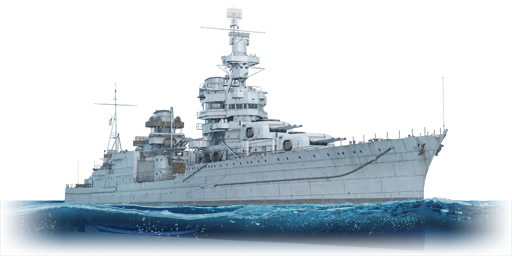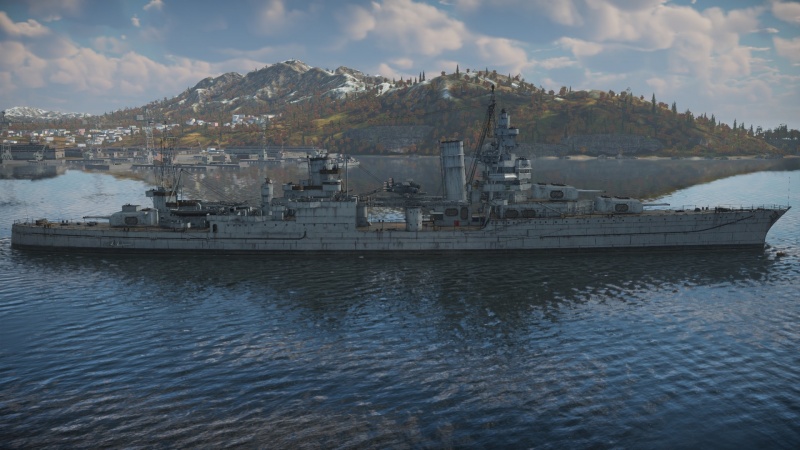USS Portland
Contents
Description
The Portland-class, USS Portland (CA-33), 1942 is a rank IV American heavy cruiser with a battle rating of 5.3 (AB/RB/SB). It was introduced in Update 1.97 "Viking Fury".
General info
Survivability and armour
USS Portland's survivability is rather mediocre for an American heavy cruiser, and rather weak compared to the enemies it often faces in battle. Portland has a main armour belt of just 57.15 mm of RHA, which can be easily penetrated by SAP and AP shells above 127 mm calibre. The magazines are protected by 146 mm of armour and sit below the waterline, meaning that they are relatively survivable. However, Portland's ready-use shell rooms are directly below the turrets and thinly-protected, meaning that they can be detonated by enemy shells and cause severe damage. Portland has a crew of 1,033 crew members, which is about average for a cruiser; the ship's four engines are placed symmetrically in groups of two, meaning that a well-placed shot can knock out at least two engines.
Mobility
Portland has decidedly average mobility for a cruiser, with a top speed of 60 km/h in Realistic battles and 70 km/h in Arcade - this is on par with most cruisers of other navies. The ship's turning circle and acceleration are nothing special, either.
| Mobility Characteristics | |||
|---|---|---|---|
| Game Mode | Upgrade Status | Maximum Speed (km/h) | |
| Forward | Reverse | ||
| AB | |||
| Upgraded | 70 | 21 | |
| RB/SB | |||
| Upgraded | 60 | 18 | |
Modifications and economy
Armament
Primary armament
The Portland carries a main armament of nine 8"/55 Mk.15 guns in three triple turrets, two fore and one aft. These guns are the standard armament for American heavy cruisers, and pack an impressive punch. The guns have good ballistics, and can access four shell types: Mk.14 Common, Mk.19 APCBC, Mk.25 HC and Mk.17 SP Common. Of these shells, the Mk.17 Special Common shell is most effective against cruisers, as it has a great explosive mass and enough penetration for most cruiser main armour belts. The Mk.19 APCBC shell can be used against heavily-armoured targets, but has a relatively small explosive mass of 1.65 kg. Finally, the HC shell, with almost 10 kilograms of explosive filler, is highly effective against destroyers and unarmoured vessels.
However, the guns have two main drawbacks. Firstly, they have the slowest reload speed of any 8-inch gun, with a fire rate of just three rounds per minute (20-second gun reload). This means that they fire much slower than their contemporaries, which typically have a fire rate of five rounds per minute (12-second reload). As well, the guns have the slowest horizontal turret rotation speed of any heavy cruiser, at just 3.1 degrees/second (comparatively, the Admiral Hipper's guns rotate at 6.8 degrees/second).
Secondary armament
The Portland carries a secondary armament of eight 5"/25 Mk.13 anti-aircraft guns, mounted on single open-mounts. These cannons are very effective medium-to-long range anti-aircraft guns, but are not effective against any armoured targets. They have access to just two shell types - Mk.36 AAC (HE-TF) and Mk.28 AAC (HE-VT). The former is a time-fuse shell (meaning that the fuze is set before the weapon is fired), while the latter is a proximity fuze shell that explodes automatically upon reaching the target. Both shells are ineffective against armoured targets, having ~35 mm of penetration. However, they are both capable of dealing with air and unarmoured targets quite effectively. The HE-VT shell is typically the better pick, as it offers greatly-improved efficiency against air targets.
The guns themselves are relatively good at short-range defence, being capable of firing at 20 rounds per minute (3-second reload). As well, they have very good vertical and horizontal firing angles. However, take note that the guns fire at a low muzzle velocity of 657 m/s which should be accounted for when manually aiming.
Anti-aircraft armament
Portland carries four quadruple 1.1 inch "Chicago Pianos". The 1.1 inch/75 Mk.1 gun, otherwise known as the "Chicago Piano" (because it was the size of a baby grand-piano), was the standard anti-aircraft armament for most American ships prior to the introduction of the 40 mm Bofors cannon. These guns are mediocre at best; though they have a good fire rate (similar to the AN-M2 Browning), they aren't too effective at dealing damage, and also jam rather quickly. As well, take note that the gun doesn't have ammunition options.
Portland also carries twelve single 20 mm Oerlikon cannons. The 20 mm Oerlikon Cannon was the standard light anti-aircraft gun for several nations, including the United States, and replaced the prior AN-M2 Browning machine gun. This weapon is an effective short-range AA gun, and has great firing angles. The gun lacks belt options, but the loaded ammunition is still quite effective against light targets. As well, the guns fire from a drum magazine that will need to be reloaded. Because of the magazine design, the gun will not jam with continuous fire.
Usage in battles
USS Portland isn't the easiest ship to play, especially given that it faces battleships often (which completely outclass it in every aspect except anti-aircraft protection) and many cruisers too (such as USS Brooklyn and USS Helena) which outclass it in terms of firepower. As such, the ship needs to be played carefully in order to succeed in battle.
Firstly, Portland's main battery is quite mediocre. The nine 203 mm guns, placed in triple turrets, have an extremely weak reload speed of 17.1 seconds with a completely spaded crew, and 20+ seconds with a stock crew. This reload speed is incompetitive against most other cruisers at the Portland's BR, and severely limits the ship's damage potential. Furthermore, Portland's guns are inaccurate - and that is, very innacurate. These weapons have a lot of trouble hitting things reliably beyond ranges of 8 kilometres, making the ship hard to play at longer ranges. These constraints mean that Portland does a lot better at closer ranges, where its main battery can hit targets reliably.
Secondly, Portland is not that survivable. Though it does have a relatively large crew size for a heavy cruiser, Portland lacks heavy armour, especially on its citadel, which houses the massive engine block. The ship also has little protection on its first stage shell rooms, which can be detonated by stray shells. Because of these constraints, you should try to use ground cover as much as possible to preserve survivability. In maps such as South Kvarken, with plenty of island covers, stay behind islands wherever possible. In open maps such as the conquest maps, your only hope will be to stay behind the front lines, and hope that enemies don't target you.
Finally, note that Portland does not have great anti-aircraft defence. While the ship does get access to several 28 mm "Chicago Piano" and 20 mm Oerlikon anti-aircraft gun mounts, these weapons lack range and power, limiting their effectiveness to ranges of less than 2.5 kilometres. Indeed, the ship does carry eight 127 mm Mk 25 guns, capable of firing AA-VT (proximity fuze) ammunition, but these weapons are not capable of firing fast enough to be able to destroy faster incoming aircraft. Because of this, you should try to stay with allied ships, particularly ships with great anti-aircraft protection. This will help ensure that your ship will stay safe from enemy aircraft.
Pros and cons
Pros:
- Improved armour protection from HE shrapnel compared to the Brooklyn
- Main guns hit relatively hard, being of a large calibre
- Thicker armour over main magazines than the Brooklyn
- Crew of 848 is above average
- Relatively good anti-aircraft protection for a pre-war American heavy cruiser
Cons:
- Long reload compared to most of its competition with minimum reload at 17.1 s
- Poor shell selection with primarily inter-war shells
- No torpedo armament
- Though strong among American CAs, anti-aircraft armament lacks hitting power and range making it relatively ineffective
History
The Portland-class cruisers were the third heavy cruiser design that the Americans produced in the interwar years, following the Northampton class. There were only two ships in this class, the USS Portland (CA-33) and the USS Indianapolis (CA-35). Interestingly the Portland class was originally planned to be a light cruiser design, being re-designated as heavy cruisers only after the hulls had been laid down in 1931.
Ships of the class were propelled by 4 screws, powered at 107,000 horsepower. This gave the ship a fairly standard top speed of 32 knots and a cruising range of 10,000 nautical miles.
Firepower was provided from 3 triple 8" guns in Mk. 14 turrets. This design was carried over from the previous Northampton class. These 280 ton turrets allowed a maximum of 41 degrees of elevation and 5 degrees of depression. The turrets were used in conjunction with the Mk.34 fire director system by, at the latest, 1945.
Media
Excellent additions to the article would be video guides, screenshots from the game, and photos.
See also
Links to articles on the War Thunder Wiki that you think will be useful for the reader, for example:
- reference to the series of the ship;
- links to approximate analogues of other nations and research trees.
External links
Paste links to sources and external resources, such as:
- topic on the official game forum;
- encyclopedia page on the ship;
- other literature.
| Bethlehem Steel Corporation | |
|---|---|
| Gun Destroyers (DD) | |
| Porter-class | USS Phelps · USS Moffett |
| Fletcher-class | USS Cowell |
| Destroyer Leaders (DL) | |
| Mitscher-class | USS Wilkinson |
| Cruiser, Light (CL) | |
| Omaha-class | USS Raleigh · USS Detroit |
| Heavy Cruisers (CA) | |
| Northampton-class | USS Northampton |
| Portland-class | USS Portland |
| Baltimore-class | USS Baltimore · USS Pittsburgh |
| Des Moines-class | USS Des Moines |
| USA heavy cruisers | |
|---|---|
| Pensacola-class | USS Pensacola |
| Northampton-class | USS Northampton |
| Portland-class | USS Portland |
| New Orleans-class | USS New Orleans |
| Baltimore-class | USS Baltimore · USS Pittsburgh |
| Des Moines-class | USS Des Moines · USS Newport News |





